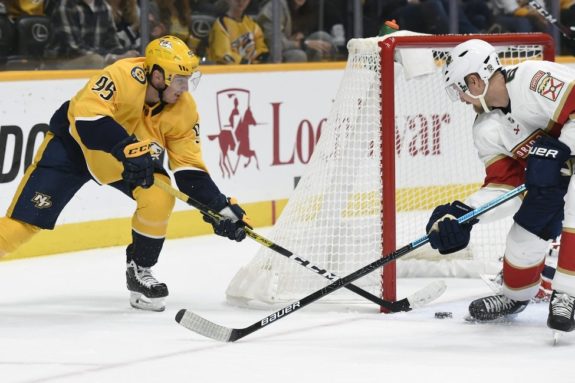One of the players I’ve been thinking about this week has been Matt Duchene and now it seems he has become available after the Nashville Predators chose to buy-out the remaining three seasons of his contract. Coming off of a down year directly after posting career-year numbers in his age-31 season, Duchene felt like a target for Nashville to try and move with three years left on his $8 million per season contract. As that clearly did not happen, here we are, with a suddenly more interesting unrestricted free agent (UFA) group.
The big-name, potentially impactful unrestricted free agent (UFA) centers this year are the much respected but aging Ryan O’Reilly, JT Compher — who is coming off a career year in the regular season followed by an awful playoff performance — the Boston-or-retirement Patrice Bergeron, and, well, that’s about it. So, to add Matt Duchene into the mix has changed everything at the proverbial 11th hour.

The Pittsburgh Penguins now have an enticing option on the board in Duchene; he could be the best solution available for the organization. When NHL front offices are looking at free agents, it’s more than just about what they cost today and what value they’ll bring to the team this season. It’s about the term of the contract at that cost, and how a decision may impact the team down the road.
Before getting into why Duchene could be the Penguin’s top choice, let’s take a look at the other top UFA centers available today.
A Quick Look at the Top UFA Centers
JT Compher
At 28, Compher played all 82 regular-season games this past season, averaging 20:32 per night. He brings defensive acumen and enough offensive ability to handle a top-six role, though ideally, he should be anchoring a strong third line. If a team signs him to a five-year, $25 million contract, what role is he playing? The price of $5 million for a third-line center is too much, as the cap ceiling has not yet risen to the point where that will be commonplace. Beyond that, what value is the signing team getting in the last two or three years of the deal? Is he still a defensive stopper? Can he still go out and get 50 points, play both special teams, and eat up 17-18 minutes a night?
Ryan O’Reilly
At 32, O’Reilly’s best seasons seem to have passed him by. Despite his 11 points in 13 regular-season games along with nine points in 11 playoff games with the Toronto Maple Leafs this past season, O’Reilly was clearly injured in the second round. He hit no one, and constantly played defensively in both the neutral and defensive zones. This was no less than his third injury of the season. So, yes, right now he can still produce points, but those same traits that make teams want to sign him (tenaciousness, fearlessness, heart — name your heroic adjective) are the same traits that are breaking his body down. As I mentioned with Malkin yesterday, O’Reilly is the type of player whose miles you want to limit to maximize their effectiveness when it counts.
The talk recently has O’Reilly potentially seeing offers of $6 million per year on a multi-year deal. How does that look even in the first two seasons, let alone when he’s 36 and 37. He’s absolutely on the most likely to end up on long-term injured reserve (LTIR) betting lines in Vegas, if such a thing exists. If O’Reilly re-signs with the Toronto Maple Leafs, or signs with the St. Louis Blues (or Colorado Avalanche) on deal in the four-year, $14-15 million range, do not be surprised. Those are the types of teams that do not have a lot of cap space, that he (and possibly his family, especially St. Louis) has an emotional attachment to (sorry, Sabres fans), and where he will have a chance to win. Combining all those elements makes multimillionaires willing to take a discount.
Patrice Bergeron
If you saw those final moments on the ice after Boston lost to Florida in a shocking Game 7 upset earlier this spring, it’ll be hard to be surprised should Bergeron retire. If he does decide to come back, it’ll be in Boston. It’s as simple as that.
Both Short and Long-Term, Duchene Is the Answer
This brings us full circle to Matt Duchene. Most content I’ve seen in the hours after his surprising buyout has discussed his potential willingness to take a large discount on a short-term contract. This is often the case when players are bought out, as they want to take a season to re-establish their value and then sign a larger contract during the next offseason. What I wouldn’t be surprised to see Pittsburgh (and any contender or wannabe contender) do is offer something similar to what the Dallas Stars offered Ryan Suter. Coming off his buyout from Minnesota, Suter signed a four-year, $14.6 million contract, with an annual average value (AAV) of $3.65 million per year, substantially less than his Minnesota deal’s AAV of $7,538,462.
Why the Suter contract concept fits for Duchene is simple: Duchene can still go. In 2021-22, he had career highs of 43 goals and 86 points. Yes, he primarily played on the wing. Yes, he had an analytics-breaking shooting percentage of 18.9 percent. I largely wash this past season as it was a down year for most of the team, and that speaks to a larger team issue (dressing room culture, coaching/system, etc.). The 2021-22 Duchene was dynamic, a firefly off the wing, using his speed to buzz around, creating scoring chances, challenging the opposing team’s pace — and that was in the playoffs. While the NHL is faster now than it was when he joined the league, he can still skate with tempo and dictate pace, which as we’ve seen many times in the past, makes it easier to play a key role for longer.

Pittsburgh’s Hockey Ops department could be thinking if Duchene can be effective for the next three or four seasons, then it allows them to see a longer opening for their Stanley Cup aspirations. Sidney Crosby has two more years left on his current contract and has made it clear he wants to keep playing past that. Aging weapons are still weapons, especially when they are elite minds like Crosby, who also happen to be elite athletes. It’s the team building around them that will make-or-break their Cup chances.
Not known for his defense, Duchene played decent defensively last season, as his 5-on-5 Corsi (puck control at 5-on-5, 50.4 percent on a non-playoff team), a positive Relative Corsi (Duchene’s Corsi relative to his teammates) of 2.2 and a positive Relative Fenwick (unblocked shots for vs. against) of 2.1. This means that he can insulate Malkin, should they spend time on the same line. Duchene can still play in the middle, moving Malkin to the wing and allowing him to not have to exert so much against a body that has a lot of miles and several surgeries on it.
For this season, Duchene would be another offensive weapon. While he may not end up being a first-line player, he would be a quality second-liner. This would also give Pittsburgh the chance to either stack two offensive lines or run three balanced offensive lines. If anyone is really concerned about his defense, remember that Mike Sullivan is the coach who got Phil Kessel to play such good defense in the 2017 NHL Playoffs that, to this day, the Rogers Sportsnet announcers repeatedly talked about how he could have easily won the Conn Smythe Award as Playoff MVP in 2017. While perhaps a touch overly simplistic, Kessel and Duchene are both offensive-minded speedsters, and speed makes it much easier to get back on defense.
Related: Roster Rebuild: Penguins Can Contend With the Right Moves
Do not be surprised if you hear about teams offering Duchene three- and four-year deals with AAVs anywhere in the $3-4 million range. That offer coming from a potential Stanley Cup contender should get the deal done. If Pittsburgh makes that offer, Duchene may well become the bridge from the Crosby/Malkin dynasty to the Brayden Yager generation.